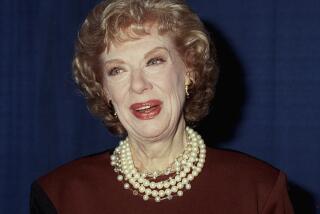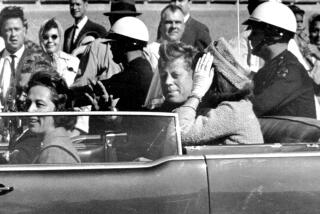On-screen and off, a melodrama
- Share via
It was a match made in illicit heaven.
Actress Gloria Swanson was one of the grand divas of Hollywood. Joseph Kennedy, the patriarch of the Kennedy clan, was one of the major movers and shakers of the film world in the 1920s. He is the only man to run three film studios -- FBO, Pathe and First National -- as well as a theater circuit at the same time.
Both were married when they fell in love in the late 1920s. Shortly thereafter, they collaborated on their first film, “Queen Kelly.” But after a year, the outrageously decadent melodrama was still nowhere near completion. It fell apart when director Erich von Stroheim ordered Swanson’s costar Tully Marshall to dribble tobacco juice on her hand during an elaborate wedding sequence.
Swanson demanded that Kennedy fire Von Stroheim and, in early 1929, that’s what Kennedy did.
“About $700,000 had been spent and it was just a disaster,” says film historian Cari Beauchamp. “So he and Gloria brought in different directors to look at what they had. Eddie Goulding is the one with the nerve to look them in the face and say, ‘Guys, I’m not touching this with a 10-foot pole.’ ”
But Goulding had a plan. He told Kennedy and Swanson that he would make a film with the actress that would be finished by summer and out in theaters by year’s end. Then Kennedy and Swanson could decide what to do with “Queen Kelly.” Goulding’s solution was perfect. The film he directed, “The Trespasser,” not only was Swanson’s first talkie, it brought the star her second Oscar nomination for best actress.
Thursday at the Academy of Motion Picture Arts and Science’s Linwood Dunn Theater, “The Trespasser” will have its first screening in Los Angeles in decades. The only known print in the U.S. is coming from the George Eastman House in Rochester, N.Y.
Beauchamp, who has spent the last several years researching and writing the book “Joseph P. Kennedy Presents,” will talk about the Kennedy-Swanson relationship at the screening. (Her book will be published next year by Knopf.)
“Trespasser,” a melodrama with songs, stars Swanson as a stenographer who elopes with the son of a wealthy family only to have the union annulled by her husband’s father. Swanson’s character, now pregnant, is forced to return to her old job. Years later, she nearly loses custody of her son when her ex-father-in-law realizes the boy may be the only hope for continuing the family lineage.
“Eddie Goulding was a pretty incredible guy,” says Beauchamp. “He was British and a bon vivant. [Screenwriter] Frances Marion was one of his mentors. He had already worked with Garbo and Crawford before Swanson.”
According to Swanson’s autobiography, says Beauchamp, the scenario for “Trespasser” was created at her kitchen table. “It was Eddie, it was Gloria and actress Laura Hope Crewes,” she says. “Hope Crewes was also a writer, and Eddie loved her dialogue. He thought she had an incredible ear for who would say what. Plus, they also had a stenographer [writing everything down].”
Sound movies were static and stilted in their infancy because the cameras were locked in one position in soundproof booths so their noise would not be picked up by stage microphones.
Because the cameras couldn’t budge, Goulding decided to move the rooms. “He created sets that walked into each other so the actors could move from room to room,” says Beauchamp. Frequently he had more than 12 cameras going simultaneously to pick up the action, and “microphones were dropped all over the sets,” she says.
“They could shoot up to 10 minutes at a time. Because it was so well-planned, scenes that would have taken days to shoot took place in an afternoon. It was done in 21 days.”
However, there weren’t any theaters available to show the talkie in America. So Kennedy decided to premiere it in London and Paris, a move that only heightened publicity in America. It first opened in Detroit and then made its way to New York and then across the country.
“It was a very big hit,” says Beauchamp, “but not big enough for everything they had lost on ‘Queen Kelly,’ mind you.” Shortly thereafter, the couple ended their relationship. And footage from “Queen Kelly” did survive -- it was featured in “Sunset Boulevard,” which starred Swanson as a silent film star and Von Stroheim as her former director and husband.
--
--
‘Joseph P. Kennedy Presents’
Where: Linwood Dunn Theater, 1313 Vine St., Hollywood
When: 7:30 p.m. Thursday
Price: Free, but tickets are required
Contact: (310) 247-3600 or go to www.oscars.org
More to Read
Only good movies
Get the Indie Focus newsletter, Mark Olsen's weekly guide to the world of cinema.
You may occasionally receive promotional content from the Los Angeles Times.











